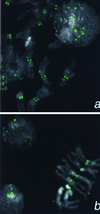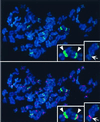Heterochromatic deposition of centromeric histone H3-like proteins
- PMID: 10639145
- PMCID: PMC15396
- DOI: 10.1073/pnas.97.2.716
Heterochromatic deposition of centromeric histone H3-like proteins
Abstract
Centromeres of most organisms are embedded within constitutive heterochromatin, the condensed regions of chromosomes that account for a large fraction of complex genomes. The functional significance of this centromere-heterochromatin relationship, if any, is unknown. One possibility is that heterochromatin provides a suitable environment for assembly of centromere components, such as special centromeric nucleosomes that contain distinctive histone H3-like proteins. We describe a Drosophila H3-like protein, Cid (for centromere identifier) that localizes exclusively to fly centromeres. When the cid upstream region drives expression of H3 and H2B histone-green fluorescent protein fusion genes in Drosophila cells, euchromatin-specific deposition results. Remarkably, when the cid upstream region drives expression of yeast, worm, and human centromeric histone-green fluorescent protein fusion proteins, localization is preferentially within Drosophila pericentric heterochromatin. Heterochromatin-specific localization also was seen for yeast and worm centromeric proteins constitutively expressed in human cells. Preferential localization to heterochromatin in heterologous systems is unexpected if centromere-specific or site-specific factors determine H3-like protein localization to centromeres. Rather, the heterochromatic state itself may help localize centromeric components.
Figures






References
-
- Flemming W. Zellsubstanz, Kern und Zelltheilung. Leipzig, Germany: F. C. W. Vogel; 1882.
-
- Wiens G R, Sorger P K. Cell. 1998;93:313–316. - PubMed
-
- Csink A K, Henikoff S. Trends Genet. 1998;14:200–204. - PubMed
-
- Willard H F. Curr Op Genet Dev. 1998;8:219–225. - PubMed
-
- Murphy T D, Karpen G H. Cell. 1998;93:317–320. - PubMed
MeSH terms
Substances
LinkOut - more resources
Full Text Sources
Other Literature Sources
Molecular Biology Databases

